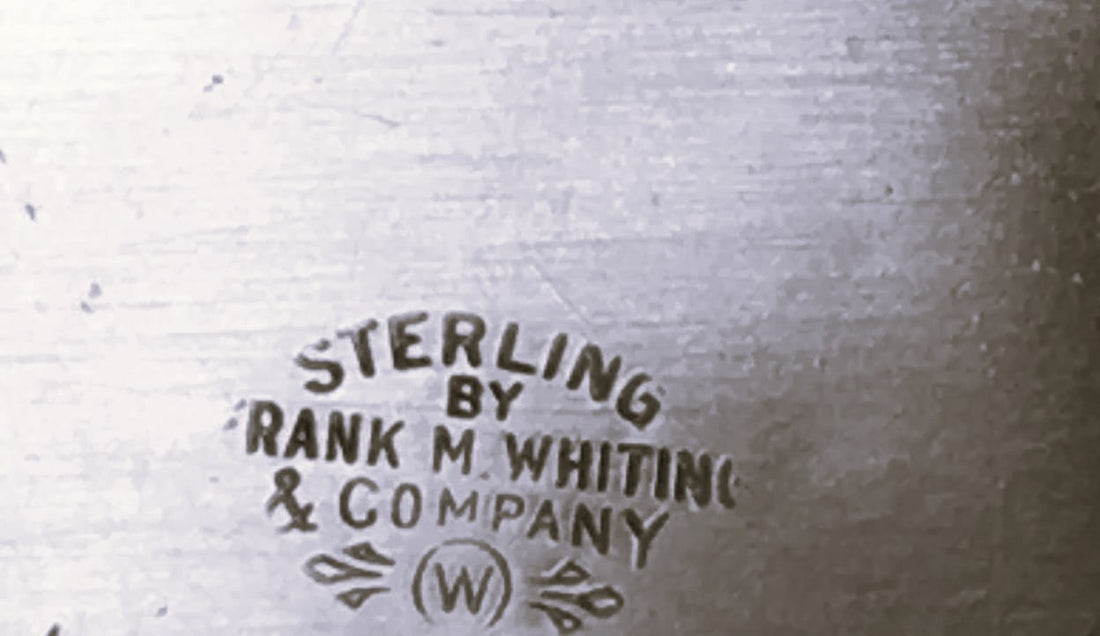
Frank M. Whiting Co.: A Journey Through Silver Elegance
Share
Discovering the Legacy of Frank M. Whiting Co.: A Journey Through Silver Elegance
Nestled in the rich tapestry of American silverware history, the Frank M. Whiting Company stands as a beacon of craftsmanship and design innovation. Originating in North Attleboro, Massachusetts, this esteemed manufacturer has left an indelible mark on the world of antiques and collectibles. Let’s delve into the captivating history and exquisite creations of the Frank M. Whiting Company.
A Storied Beginnings
The saga of the Frank M. Whiting Company began in 1878, under the name Holbrook, Whiting & Albee. This early iteration of the company was established in North Attleboro, a hub for silver production in the 19th century. The firm's initial foray into silverware set the stage for a legacy of remarkable craftsmanship.
By the early 1940s, Whiting had become part of the Ellmore Silver Company. Despite the turbulent times, the brand continued to flourish until Ellmore’s closure around 1960. The story didn’t end there; Crown Silver Co. of New York acquired Whiting’s dies, ensuring that the iconic designs would continue to grace tables across America.
Signature Marks and Iconic Patterns
The Frank M. Whiting Company is celebrated for its distinctive silverware patterns and elegant marks. Early in its history, Whiting used a company mark featuring a griffon and a shield with a ‘W,’ which evolved into a more streamlined ‘W’ in a circle flanked by stylized leaves after 1896.
Whiting's flatware patterns are a testament to its innovation and aesthetic prowess. From the classical allure of “Adam” (1907) to the intricate beauty of “Lily of the Valley” (1885), each pattern showcases the company’s commitment to exceptional design. The “Antique-Chased” (1882) and “Georgian Shell” patterns highlight the elaborate detailing that defined Whiting’s style, while the “Pompadour” (1895-1898) and “Victoria/Florence” patterns reflect the period's opulence.
A list of Frank M. Whiting Company patterns and collections, ordered alphabetically by name, followed by the year manufactured:
- Adam - 1907
- Alhambra - 1880
- Antique-Chased - 1882
- Antique Lily-Engraved - 1882
- Antique Rosette - 1880
- Arabesque - 1875
- Armor - 1871
- B Burlington - 1914
- Bead - 1880
- Berry - 1880
- Botticelli - 1875
- Chateau - 1923
- Colonial - 1907
- Cox - 1850
- Dandelion - 1890
- Diamond - 1880
- Dorothy Vernon - 1909
- Dresden - 1896
- Duchess - 1906
- Duke of York - 1900
- Eastlake - 1880
- Egyptian - 1875
- Fairfield - 1912
- French Thread - 1880
- Fruit - 1880
- Gem Leaf - 1880
- Gibney - 1862
- Grape - 1855
- Grecian - 1862
- Honeysuckle - 1870
- Hyperion - 1888
- Imperial Queen - 1893
- Indian - 1874
- Italian - 1880
- Ivy - 1865
- Japanese - 1874
- Jenny Lind - 1920
- Keystone - 1888
- King Albert - 1919
- King Edward - 1901
- Lady Baltimore - 1910
- Laureate - 1890
- Lily - 1870
- Lily (1902) - 1902
- Lily of the Valley - 1885
- Livingston - 1914
- Louis XV - 1891
- Madam Jumel - 1908
- Madam Morris - 1909
- Mandarin - 1918
- Mask - 1889
- Neapolitan/Kings Court - 1890
- Newport - 1917
- Old King - 1890
- Oriana - 1916
- Oval Thread - 1880
- Oval Twist - 1880
- Persian - 1880
- Pompeian - 1913
- Pompadour - 1895
- Prince Albert - 1855
- Radiant - 1895
- Roses and Scrolls - circa 1890
- Rosette - 1890
- St. Martin's - 1916
- Stratford - 1910
- Stuart - 1912
- Violet - 1905
- Wedgwood - 1910
A Legacy in Craftsmanship
Frank M. Whiting’s contribution to silverware is not merely about beautiful patterns but also about the meticulous craftsmanship that underpins each piece. The company’s use of sequential design numbers, introduced around 1880, allowed for systematic tracking and provided a fascinating glimpse into its production history. This system, along with the variety of patterns and design schemes, underscores Whiting’s dedication to both innovation and tradition.
The Evolution of Whiting
The company’s journey saw significant milestones, including its acquisition by Gorham in 1924. This transition marked a new chapter, with Whiting’s operations moving to Providence, Rhode Island. Despite this change, Whiting’s legacy continued to influence the silverware industry through its unique patterns and exceptional quality.
Today, collectors and enthusiasts cherish Whiting pieces for their historical significance and timeless elegance. The enduring appeal of Whiting’s designs reflects a legacy of artistry and craftsmanship that transcends generations.
Collecting Whiting Silverware
For those with a passion for antiques and historical silverware, Frank M. Whiting’s creations offer a tangible connection to a bygone era. Whether you’re drawn to the classic lines of the “Duke of York” (1900) or the detailed intricacies of the “Heraldic” (1880), Whiting’s silverware provides a window into the elegance of the past.
As you explore the world of Frank M. Whiting, you’re not just discovering silverware; you’re uncovering a piece of American history. Each pattern and piece tells a story of craftsmanship and design that continues to captivate and inspire.
In Conclusion
The Frank M. Whiting Company’s legacy is a shining example of American silverware excellence. From its humble beginnings in North Attleboro to its integration into the larger Gorham portfolio, Whiting’s journey is one of resilience, artistry, and enduring appeal. For those who appreciate the artistry of antique silverware, Whiting’s creations remain a testament to the beauty and elegance of a bygone era.
Explore the rich history and exquisite patterns of Frank M. Whiting Co. and discover why these timeless pieces continue to be treasured by collectors and enthusiasts alike.